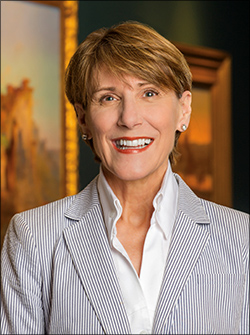
On January 18, 1898, 200 citizens saw the incorporation of the city of Tulsa. Within four years, the Tulsa Commercial Club formed the city’s first brass band; and by 1911, Tulsa’s Hyechka (music) club was hosting the New York Symphony at a newly built Grand Opera House on Second Street. The Ruskin Art Club, The Tuesday Book Club and the Thimble Club — social and cultural drivers of the city’s earliest days all started by women — put the magic into Magic City, establishing the arts as fundamental to Tulsa’s growth.
None of those early Tulsans could have imagined that the discovery of oil would give rise to the legacy of Thomas Gilcrease, whose wealth and vision created a world-class art collection and historical archive as vast and diverse as the American experience itself. Owned by the City of Tulsa and managed by The University of Tulsa, Gilcrease Museum provides compelling insights into America, literally inviting visitors to “find themselves at Gilcrease.” Soon to undergo a $65 million expansion and remodel, Gilcrease is poised to advance Tulsa as a destination while better serving its community through inspiring experiences and access to life-long learning.
The George Kaiser Family Foundation in partnership with TU and Gilcrease Museum has made the Helmerich Center for American Research the home of the Bob Dylan Archive. The Bob Dylan Center, planned for the city’s arts district, will be the public entity for the archive which is open to scholarly research. Leading up to the downtown Center’s opening, public events to celebrate Dylan’s music and impact are being planned.
Gilcrease and the Philbrook Museum of Art represent the synergy between the arts and the community. Visitors to Philbrook can explore its collection assembled by oilman Frank Phillips, enjoy beautifully manicured gardens and start the weekend with fun family programming every Friday evening.
The first time, the words “Arts and Entertainment District” appeared on a master plan for downtown Tulsa in 1986, the area little resembled the attraction it is today. Named officially The Tulsa Arts District, the area has delivered on that early promise and owns the weekend scene in Tulsa. First Friday Art Crawl invites visitors to kick off each month with exploring the district’s galleries including Philbrook Downtown, TU’s Henry Zarrow Center for Art and Education, the Woody Guthrie Center and 108 Contemporary among others.
Guthrie Green, a vibrant urban space that engages young and old through music and theater, welcomed more than 300,000 guests to free performances in 2017. Also located in the Tulsa Arts District, the Hardesty Arts Center is a holistic space for guests to encounter contemporary art on the first floor, to move through (and on and under) an immersive, artist-led installation on the second floor and to practice their own creativity on the third floor.
The Performing Arts Center in downtown Tulsa offers local, national and international performances and gallery art throughout the year. The PAC serves as home to Tulsa Ballet and Tulsa Symphony Orchestra. Tulsa Ballet offers world-class performances from classical to contemporary while the Tulsa Symphony provides a collaborative and engaging environment with the 21st century concept of musicians governing the repertoire, guest conductors and soloists each season.
I would be remiss if I omitted contributions from TU, which invites the public to campus to enjoy art exhibitions, theater productions, concerts, films and fascinating lectures. Through these activities, the university aims to entertain, engage and educate our community.
Tulsa arts, which represent the distinct and creative spirit that is my hometown, continue to be an essential and sustaining contribution to our economy. As important as they have been to our past, the arts are proving to be even more important to our future nourishing a creative renaissance in Tulsa and throughout our region.